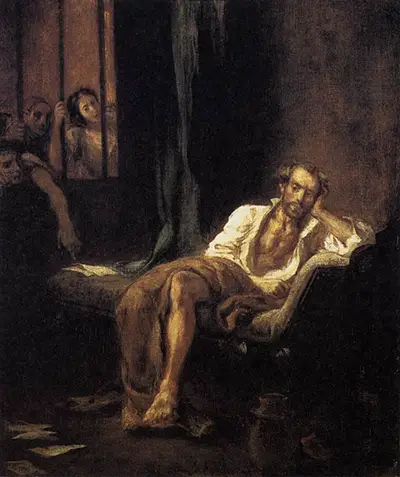 Buy Art Prints Now
Buy Art Prints Nowfrom Amazon
* As an Amazon Associate, and partner with Google Adsense and Ezoic, I earn from qualifying purchases.
Tasso in the Madhouse was completed by Delacroix in 1839 and it now resides within a private collection, with its precise whereabouts not known. This oil work is 60cm tall and 50cm wide.
If we look at the composition in front of us, we see an illuminated figure relaxing on a sofa whilst several female figures appear from behind a door and attempt to get his attention. Most of the scene is particularly darkened and this colour scheme is suited to the sombre nature of the scene in front of us. Clearly the females are residents of the 'madhouse' described in the title, and for some reason this male figure finds himself living here as well. His unfortunate predicament is underlined by how one of the women's arms leans across into his room, infringing into his personal space and continuing this theme of a lost liberty, whilst existing in dark and depressing surroundings. It was rare for artists to approach mental health issues in any way during this period, but Theodore Gericault would do this several times in his career, giving us the likes of Insane Woman.
The figure in this painting who sits in the foreground is actually believed to be Torquato Tasso who was a famous Italian poet of the 16th century. Literature would be a key driver in the French Romanticist movement and so its contributors would generally be particularly well read, which indeed Delacroix was. Sadly the poet would struggle with mental health issues which eventually led to bouts of violence and from that point onwards he was confined to a madhouse. Delacroix clearly felt sympathy with that part of his life and therefore chose to complete this artwork in which he is depicted as fairly healthy in appearance and perhaps hard done by to have been institutionalised in the way that he was. Delacroix was biased towards the creative mind, and very much took his side against those who chose to imprison him.
A good number of this artist's paintings can be found in private collections but the most significant tend to be part of public collections, which allows his followers to see his best work up close and personal. He remains a major draw at the Louvre, thanks to classic paintings such as Liberty Leading the People and Death of Sardanapalus, even though there are so many other great names competing for attention in this historic and breathtaking venues. His lesser known pieces continue to come up for sale every now and again, with undiscovered items from his career appearing every once in a while.



